
The catastrophic first minute
During the initial hours of the May 18 activity, people were obviously
confused about the nature and sequence of the phenomena taking place. Did
the eruption trigger the 5.1 magnitude earthquake or did the earthquake
trigger the eruption? Or were both associated with some other, but unknown,
cause or causes? At first, these questions and others could not be answered
because of the rapidity of developments and the initial lack of firsthand
observations by people who were close to the mountain and who survived the
catastrophe. It was not until many hours, indeed days, later that scientists
were able to reconstruct clearly the sequence of events. The reconstruction
was aided by eyewitness accounts. Geologists Keith and Dorothy Stoffel,
flying over the volcano in a small plane when the earthquake struck, observed
"minor landsliding of rock and ice debris" into the crater. Within
the next 15 seconds, the north flank of the volcano "began to ripple
and churn up, without moving laterally." At the same time the Stoffels
were witnessing from the air the developing debris avalanche, a remarkable
series of ground-based photographs was being taken by Keith Ronnholm and
Gary Rosenquist from Bear Meadows, a camping area located about 11 miles
northeast of Mount St. Helens. Seconds after the earthquake, William Dilly,
a member of the Rosenquist party, noticed through binoculars that the north
flank was becoming "fuzzy, like there was dust being thrown down the
side" and shouted that the "mountain was going." Within seconds
Rosenquist began taking photographs in rapid succession.
Frame-by-frame analysis of the Rosenquist photographs, taken within a
span of about 40 seconds, together with seismic and other evidence, established
the following sequence of events during the first minute of the climactic
eruptions. The times indicated are in hours, minutes, and seconds (Pacific
Daylight Time).
These photographs were selected from the sequence taken
by Gary Rosenquist (©copyright Gary Rosenquist 1980).
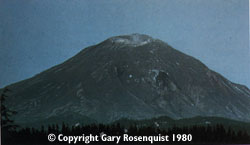
08:27 (approximate) Pre-earthquake
view of the bulge on the volcano's north flank produced by the growing cryptodome
of magma intruded since March 20. About 5 minutes later (08:32:11.4 PDT),
a 5.1 magnitude earthquake struck beneath the mountain at shallow depth. |
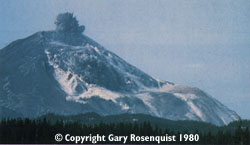
08:32:53.3 The first slide
block now had dropped sufficiently to expose more of the cryptodome magma,
accelerating the explosive expansion of gases in the magma and the eruption
of the first magmatic material of the 1980 eruptions. |

08:32:47.0 Estimate of the
time of the first photograph in Rosenquist's sequence that shows movement
of the mountain. By this time, the first slide block had already dropped
about 2,300 feet and a second block behind it had slid 330 feet. The beginning
of the north flank's collapse and downward movement to initiate the debris
avalanche was estimated to be 26 seconds earlier (08:32:21.0 PDT). |
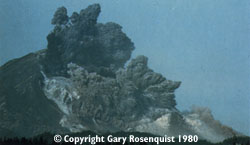
08:33:03.7 The continuing movement
of the slide blocks and explosions had now thoroughly "uncorked"
the magmatic system of the cryptodome, and old and new (magmatic) debris
were blasted outward by increasingly more powerful explosions. The high-velocity
lateral blast cloud, with its clearly visible trajectory trails of large
blocks, was overtaking the slower moving debris avalanche. |
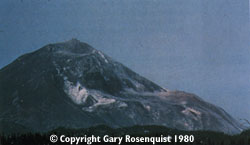
08:32:49.2 A little more than
2 seconds later, as the slide blocks continued to move, the initial explosions
of the vertical eruption column as well as the lateral blast, although obscure,
had already begun. |
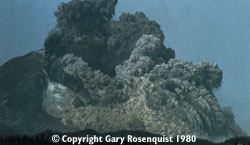
08:33:18.8 Less than a minute
after the start of the debris avalanche, the eruption of Mount St. Helens
was in full fury, further enlarging the crater as smaller slide blocks fell
into the vent and were blasted away. The leading front of the lateral blast
now had completely overtaken the debris avalanche. |
The lateral blast at the vent probably lasted no more than about 30 seconds,
but the northward radiating and expanding blast cloud continued for about
another minute, extending to areas more than 16 miles from the volcano.
Shortly after the blast shot out laterally, the vertically directed ash
column rose to an altitude of about 16 miles in less than 15 minutes, and
the vigorous emission of ash continued for the next 9 hours. The eruption
column began to decline at about 5:30 p.m. and diminished to a very low
level by early morning of May 19.
The extraordinary photographic documentation of the first minute enabled
scientists to reconstruct accurately what had happened. The 5.1-magnitude
earthquake caused the gravitational collapse of Mount St. Helens' north
flank, which produced the debris avalanche and triggered the ensuing violent
lateral and vertical eruptions. From a scientific perspective, it was fortunate
that the initial May 18 events occurred during daylight hours under cloudless
conditions; otherwise, the sequence of events during that crucial first
minute following the earthquake would have been difficult to reconstruct
precisely.
 Mudflows and floods
Mudflows and floods
Impact and aftermath

URL: <https://pubs.usgs.gov/gip/msh/catastrophic.html>
Contact: John Watson
Last updated: 06.25.97






